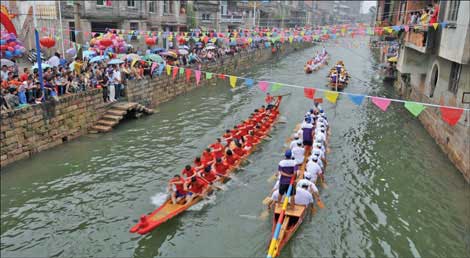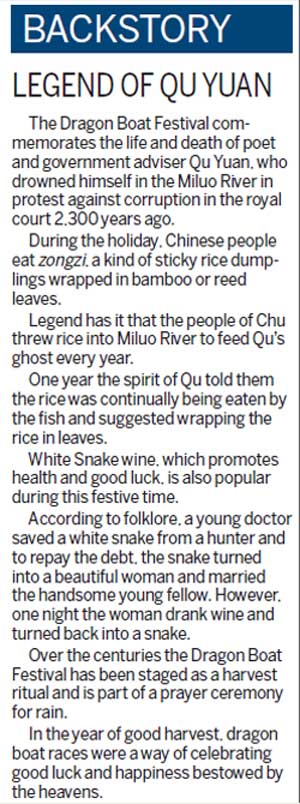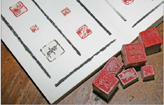Enter the Dragon
Updated: 2011-06-03 11:11
By Liu Xiaozhuo (China Daily European Weekly)
 |
|
The dragon boat racing tradition harks back more than 2,300 years and commemorates the death of a famous poet who drowned himself to protest against government corruption. Zhang Bin / China Daily |
This year's Dragon Boat Festival kicks off China's very first televised national racing tournament
A group of Beijing high school students are splashing about on Houhai Lake as they prepare for the Dragon Boat Festival races on June 6. The dozen or so competitors paddle to a rhythmic drumbeat and laugh loudly when they cruise past the finish line. "The China Dragon Boat Tournament is about to kick off and my dream to race in that event," one young paddler says.
The Dragon Boat Festival is one of the nation's most important traditional events and two years ago was elevated as a national holiday.
Thousands of dragon boat races will take place in rivers and in lakes all across the nation but for the first time, a major televised event will be staged to give the sport the biggest boost it has ever received. The China Dragon Boat Tournament will tour six cities and be watched by hundreds of millions of viewers.
First stop on June 5 is Jiangyin, a water town located in Jiangsu province. It was one of the cities that successfully won the right to host the race and in doing so will attract hordes of tourists.
"We predict that 300,000 to 400,000 spectators will come to each site and enjoy the event in person," says Hu Jianguo, the head of Leisure Sports Administration Center, which is organizing the event with national broadcaster CCTV.
 |
"Our purpose is to spread dragon boat culture through holding magnificent races between top teams to attract people to watch," says Hu. "We want the dragon boat race to become more popular and make it part of a national fitness campaign."
Dragon boats are traditionally made of teak wood of various designs and sizes. A typical dragon boat is between 15- and 30-meters long and about 2-meters wide, with a wooden dragonhead attached at the bow and a dragon tail at the stern.
Many regions of China have a tradition of dragon boat races, and there are dozens of different kinds of dragon boats used. But not all of them are built for speed.
One special kind of dragon boat is called cailong, which means colorful dragon, and is very long and usually packed with up to 200 paddlers. The participants all wear colorful costumes, often sporting bright red and yellow, and together with the beautifully decorated dragon boat, make quite a spectacle as they move across the water.
Cailong paddlers also entertain the audience through performances but they have to be careful. Although the cailong is very long, it is much narrower, not more than 1 meter wide, so the paddlers needed to maintain good balance.
In a regular dragon boat, there are usually 22 people on board and the two members of the crew include a steersman at the rear of the boat in charge of the direction and a drummer, who pounds away to produce the "heartbeat" of the dragon boat.
Dragon boat racing is not just a Chinese event and over the years has gained more popularity internationally with dragon boat federations set up all over the world.
With the support of the International Dragon Boat Federation, an international non-governmental, not-profit world organization, more than 50 countries hold dragon boat events every year.
In 2009, the World Championships were held in the Czech Republic, and attracted almost 3,000 athletes and 134 crews. More than 900 competitors are women and 600 are under the age of 18.
Last year the ninth European Championship was held in Amsterdam, Netherlands and 18 teams from all across Europe participated. Slovakia dominated the under-23s races, while Germany was prominent in the junior and senior divisions.
The British women's team won all three gold medals in women's division and Hungary topped the 2,000m race.
But not all dragon boat racing is serious and many groups have been formed as social clubs.
In the Chinese capital, the Beijing International Dragon Boat Team is one such group and it is made up of Chinese nationals and expats.
Dragon boating enthusiast He Ming founded the team in 2002 and says more than 2,000 expats have taken part in the activity.
"Many foreigners in Beijing are interested in dragon boating and want to join an organization that allows them to congregate for training and competing," He says.
American Alicia Noel, a business lecturer at the China Agricultural University in Beijing, has been a team member for almost three years.
"Being on the boat and learning to paddle with the others is a lot of fun and there is a great sense of conviviality among the team," she says.
Beijing International Dragon Boat Team also helps companies and schools to do team building.
"We use dragon boating to improve employees' team spirit and it is also a great chance to spread dragon boat culture," He says.
E-paper

Pearl on the Yangtze
Wuxi is considered a town of natural beauty and its motto is "city of water and warmth".
Prose and consternation
Riding on a mystery train
Way of a warrior
Specials

Wealth of difference
Rich coastal areas offer contrasting ways of dealing with country's development

Seal of approval
The dying tradition of seal engraving has now become a UNIVERSITY major

Making perfect horse sense
Riding horses to work may be the clean, green answer to frustrated car owners in traffic-trapped cities
